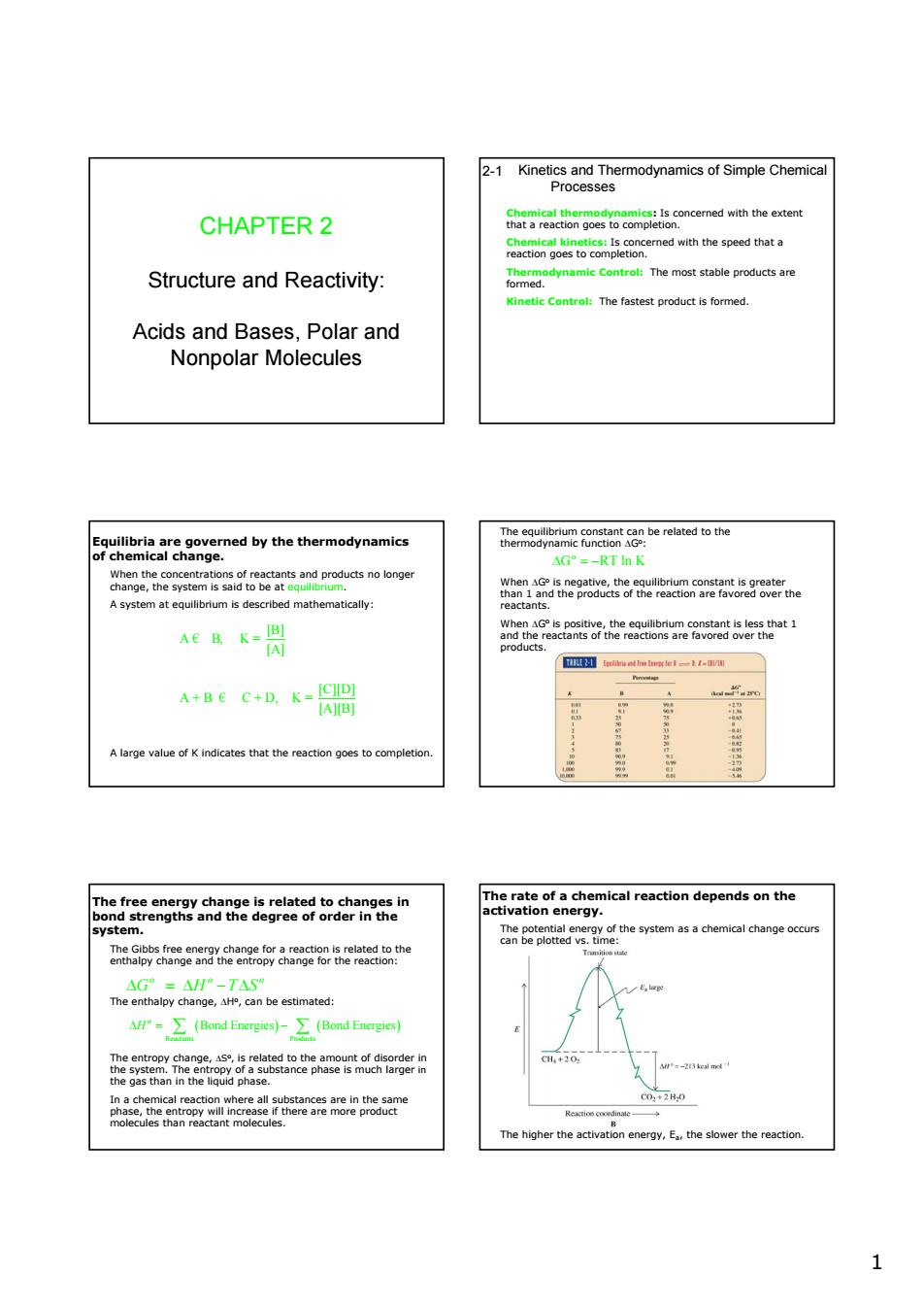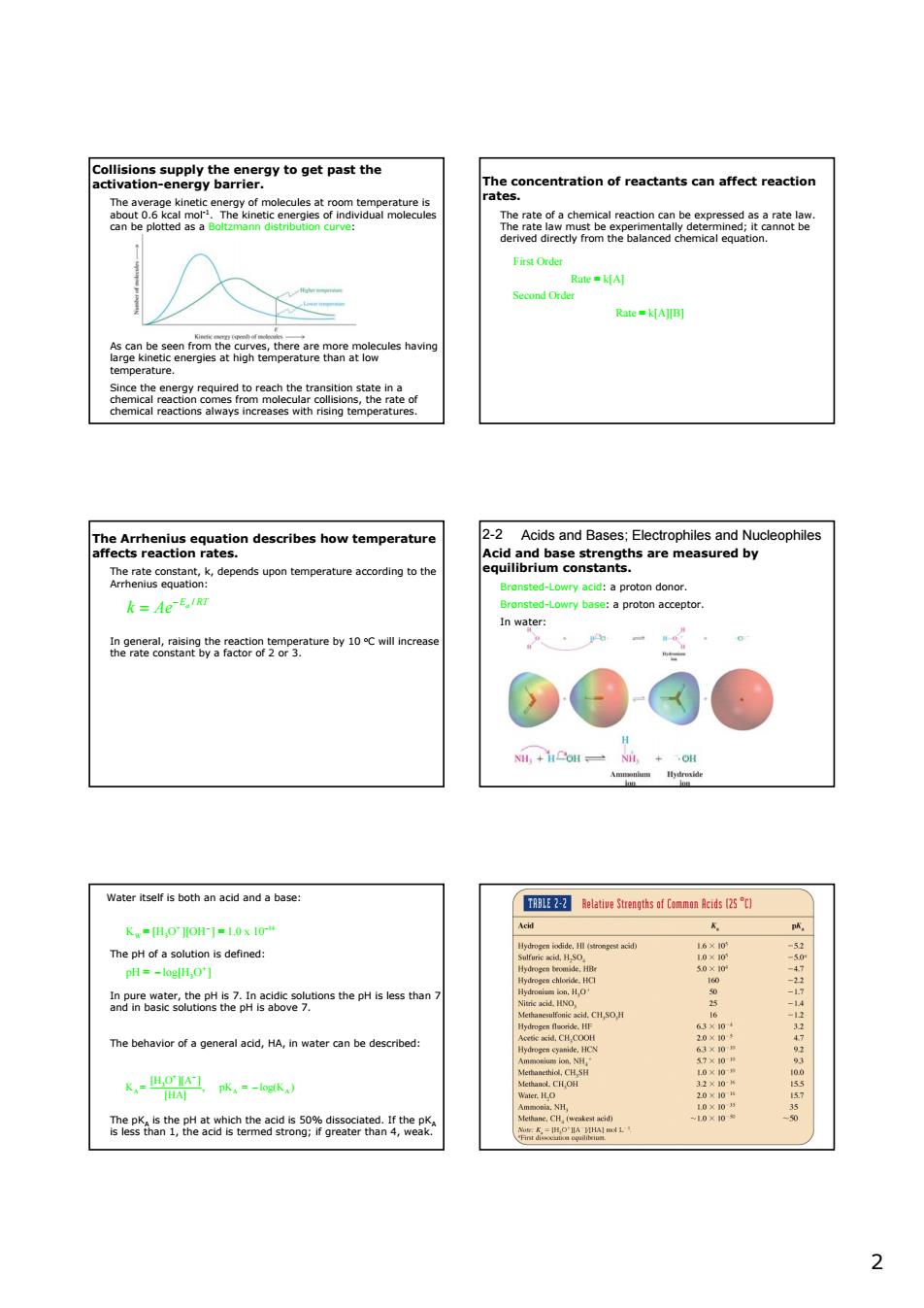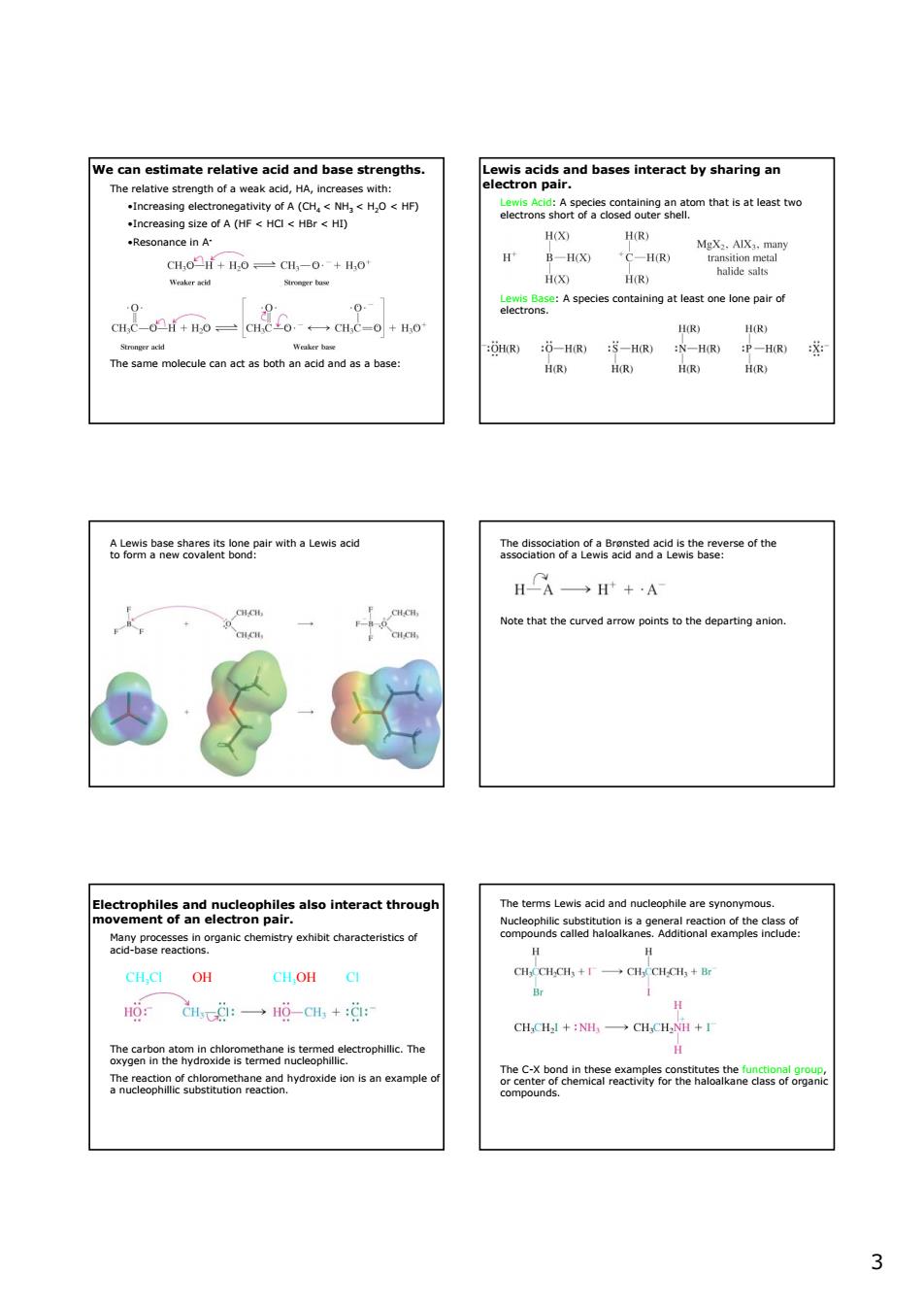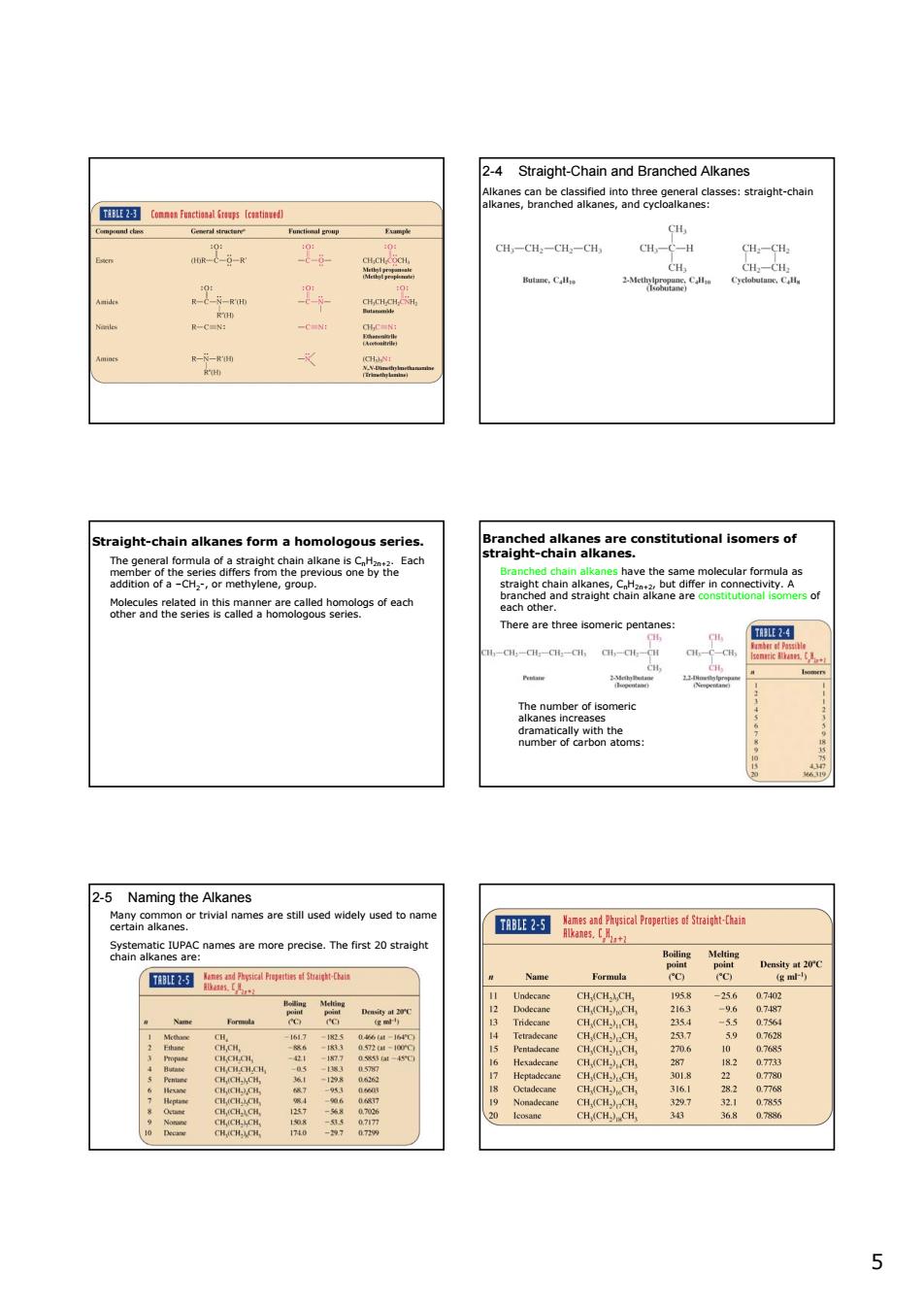
2-1 Kinetics and Thermodynamics of Simple Chemical Processes CHAPTER 2 atarectongoeocome5 that Structure and Reactivity: The products The ormed. Acids and Bases,Polar and Nonpolar Molecules heuwhancf8netantentereatedothe cagen8gno5gocarindpmotsnoonge agaeag6an AEBK-周 s ABec+Bk-器 Alarge value K indicates that aivtsaevmlcalreactondependsonthe chemical change enhanehe AFr-∑(Bond-)∑(Bond) We-ici nd n energy.E..the slower the rea 1
1 CHAPTER 2 Structure and Reactivity: Acids and Bases, Polar and Nonpolar Molecules Kinetics and Thermodynamics of Simple Chemical Processes 2-1 Chemical thermodynamics: Is concerned with the extent that a reaction goes to completion. Chemical kinetics: Is concerned with the speed that a reaction goes to completion. Thermodynamic Control: The most stable products are formed. Kinetic Control: The fastest product is formed. Equilibria are governed by the thermodynamics of chemical change. When the concentrations of reactants and products no longer change, the system is said to be at equilibrium. A system at equilibrium is described mathematically: [B] A B, K = [A] [C][D] A + B C + D, K = [A][B] or € € A large value of K indicates that the reaction goes to completion. The equilibrium constant can be related to the thermodynamic function ΔGo: o Δ =− G RT ln K When ΔGo is negative, the equilibrium constant is greater than 1 and the products of the reaction are favored over the reactants. When ΔGo is positive, the equilibrium constant is less that 1 and the reactants of the reactions are favored over the products. The free energy change is related to changes in bond strengths and the degree of order in the system. The Gibbs free energy change for a reaction is related to the enthalpy change and the entropy change for the reaction: o oo Δ =Δ − Δ G H TS The enthalpy change, ΔHo, can be estimated: ( )( ) Reactants Products Bond Energies Bond Energies o Δ= − H ∑ ∑ The entropy change, ΔSo, is related to the amount of disorder in the system. The entropy of a substance phase is much larger in the gas than in the liquid phase. In a chemical reaction where all substances are in the same phase, the entropy will increase if there are more product molecules than reactant molecules. The rate of a chemical reaction depends on the activation energy. The potential energy of the system as a chemical change occurs can be plotted vs. time: The higher the activation energy, Ea, the slower the reaction

The c concentration of reactants can affect reaction Re=对A同 的s322eeh色e代saeo g n describes how temper ature 2-2 Acids and Bases:Electrophiles and Nucleophiles Acdand base are measured by :aproton dono wy ase:a proton a In water: Water itself is both an acid and a base R,=l.0°0-1=10x0 Thended pll=-logll,O' tions the pH is less than The behavior of a general acid,HA,in water can be described: k,-k,-k小 thanthemr 2
2 Collisions supply the energy to get past the activation-energy barrier. The average kinetic energy of molecules at room temperature is about 0.6 kcal mol-1. The kinetic energies of individual molecules can be plotted as a Boltzmann distribution curve: As can be seen from the curves, there are more molecules having large kinetic energies at high temperature than at low temperature. Since the energy required to reach the transition state in a chemical reaction comes from molecular collisions, the rate of chemical reactions always increases with rising temperatures. The concentration of reactants can affect reaction rates. The rate of a chemical reaction can be expressed as a rate law. The rate law must be experimentally determined; it cannot be derived directly from the balanced chemical equation. First Order Rate = k[A] Second Reaction: A B, Reaction: A + B C + Order D, Rate = k[A][B] → → The Arrhenius equation describes how temperature affects reaction rates. The rate constant, k, depends upon temperature according to the Arrhenius equation: / Ea RT k Ae− = In general, raising the reaction temperature by 10 oC will increase the rate constant by a factor of 2 or 3. 2-2 Acids and Bases; Electrophiles and Nucleophiles Acid and base strengths are measured by equilibrium constants. Brønsted-Lowry acid: a proton donor. Brønsted-Lowry base: a proton acceptor. In water: Water itself is both an acid and a base: + 14 W 3 + 22 3 o K = [H O ][OH ] = 1.0 x 10 H O + H O H O + OH at 25 C − − − ƒ + 3 pH = log[H O ] − The pH of a solution is defined: In pure water, the pH is 7. In acidic solutions the pH is less than 7 and in basic solutions the pH is above 7. The behavior of a general acid, HA, in water can be described: + 2 + 3 A 3 A A [H O ][A ] K = , pK = log(K ) [HA HA + H O H O ] + OH − − − ƒ The pKA is the pH at which the acid is 50% dissociated. If the pKA is less than 1, the acid is termed strong; if greater than 4, weak

We can estimate relative acid and base strengths. Lewis acids and bases interact by sharing an ecrohm thatwo H(X H(R) B-HOX)C-H(R) H(R) contanngnof HR) HR HR) o6m55aetereieeearwhaLewsadd o5806m2gomotaeC5Suseereofhe HCA→H+·A the curved ponts to the departing The terms Lewis acid and nucleophile are syno CH.CI OH CH.OH CI CHy+:NCH,H+】 e,amtnantomanciegetha5epedectophilcTme 3
3 We can estimate relative acid and base strengths. The relative strength of a weak acid, HA, increases with: •Increasing electronegativity of A (CH4 < NH3 < H2O < HF) •Increasing size of A (HF < HCl < HBr < HI) •Resonance in A- + 32 3 2 + 24 3 4 2 3 HNO + H 0 NO + H O H SO + HNO HSO + H NO − − ƒ ƒ The same molecule can act as both an acid and as a base: Lewis acids and bases interact by sharing an electron pair. Lewis Acid: A species containing an atom that is at least two electrons short of a closed outer shell. Lewis Base: A species containing at least one lone pair of electrons. + H+O H H O H −&& & −→−−& && && A Lewis base shares its lone pair with a Lewis acid to form a new covalent bond: The dissociation of a Brønsted acid is the reverse of the association of a Lewis acid and a Lewis base: Note that the curved arrow points to the departing anion. Electrophiles and nucleophiles also interact through movement of an electron pair. Many processes in organic chemistry exhibit characteristics of acid-base reactions. H O, 2 Δ CH Cl C 3 3 + Na + Na OH O ⎯⎯⎯→ H H Cl The carbon atom in chloromethane is termed electrophillic. The oxygen in the hydroxide is termed nucleophillic. The reaction of chloromethane and hydroxide ion is an example of a nucleophillic substitution reaction. The terms Lewis acid and nucleophile are synonymous. Nucleophilic substitution is a general reaction of the class of compounds called haloalkanes. Additional examples include: The C-X bond in these examples constitutes the functional group, or center of chemical reactivity for the haloalkane class of organic compounds

2-3 Functional Groups:Centers of Reactivity onasAetwedreertomso0aor9n8ne8ecp6i6ah Cl-cits c-cH:HC-cH c-cacH onyo unds of hydrogen and carbon which contair mples of the cass o. Many functional groups contain polar bonds r8an adslfcompondrmed a upsecule in the
4 2-3 Functional Groups: Centers of Reactivity Functional groups are groups of atoms at sites of comparatively high chemical reactivity. They control the reactivity of the molecule as a whole. Hydrocarbons are molecules that contain only hydrogen and carbon. Alkanes are compounds of hydrogen and carbon which contain only single bonds. When the carbon atoms form a ring, the compounds are called cycloalkanes. Alkenes are hydrocarbons containing one or more C-C double bonds while alkynes contain one or more C-C triple bonds: Benzene, C6H6, and its derivatives are examples of the class of organic compounds called aromatic: Many functional groups contain polar bonds Haloalkanes have already been introduced. Alcohols (C-O-H) and ethers (C-O-C) can be converted into a large variety of other functionalities: The carbonyl functionality, C=O, is found in aldehydes, ketones, and carboxylic acids: Alkyl nitrogen and sulfur compounds are named amines and thiols: R represents a part of an alkane molecule in the following common functional groups:

2-4 Straight-Chain and Branched Alkanes ganes,52ahendgaieanaeeasnen2casss:taigt-dhan CH-CH,-CH-CH CH -CN ight-chain alkanes form a homologous series cieranahe5iewameareme6oenamegsofesh There are -Cl-0t-0l 0l-c 2-5 Naming the Alkanes are still used widely usedt certain alkanes. are more precise.The first 20 straigh a为s l Sght-Chais 5
5 2-4 Straight-Chain and Branched Alkanes Alkanes can be classified into three general classes: straight-chain alkanes, branched alkanes, and cycloalkanes: Straight-chain alkanes form a homologous series. The general formula of a straight chain alkane is CnH2n+2. Each member of the series differs from the previous one by the addition of a –CH2-, or methylene, group. Molecules related in this manner are called homologs of each other and the series is called a homologous series. Branched alkanes are constitutional isomers of straight-chain alkanes. Branched chain alkanes have the same molecular formula as straight chain alkanes, CnH2n+2, but differ in connectivity. A branched and straight chain alkane are constitutional isomers of each other. There are three isomeric pentanes: The number of isomeric alkanes increases dramatically with the number of carbon atoms: 2-5 Naming the Alkanes Many common or trivial names are still used widely used to name certain alkanes. Systematic IUPAC names are more precise. The first 20 straight chain alkanes are: